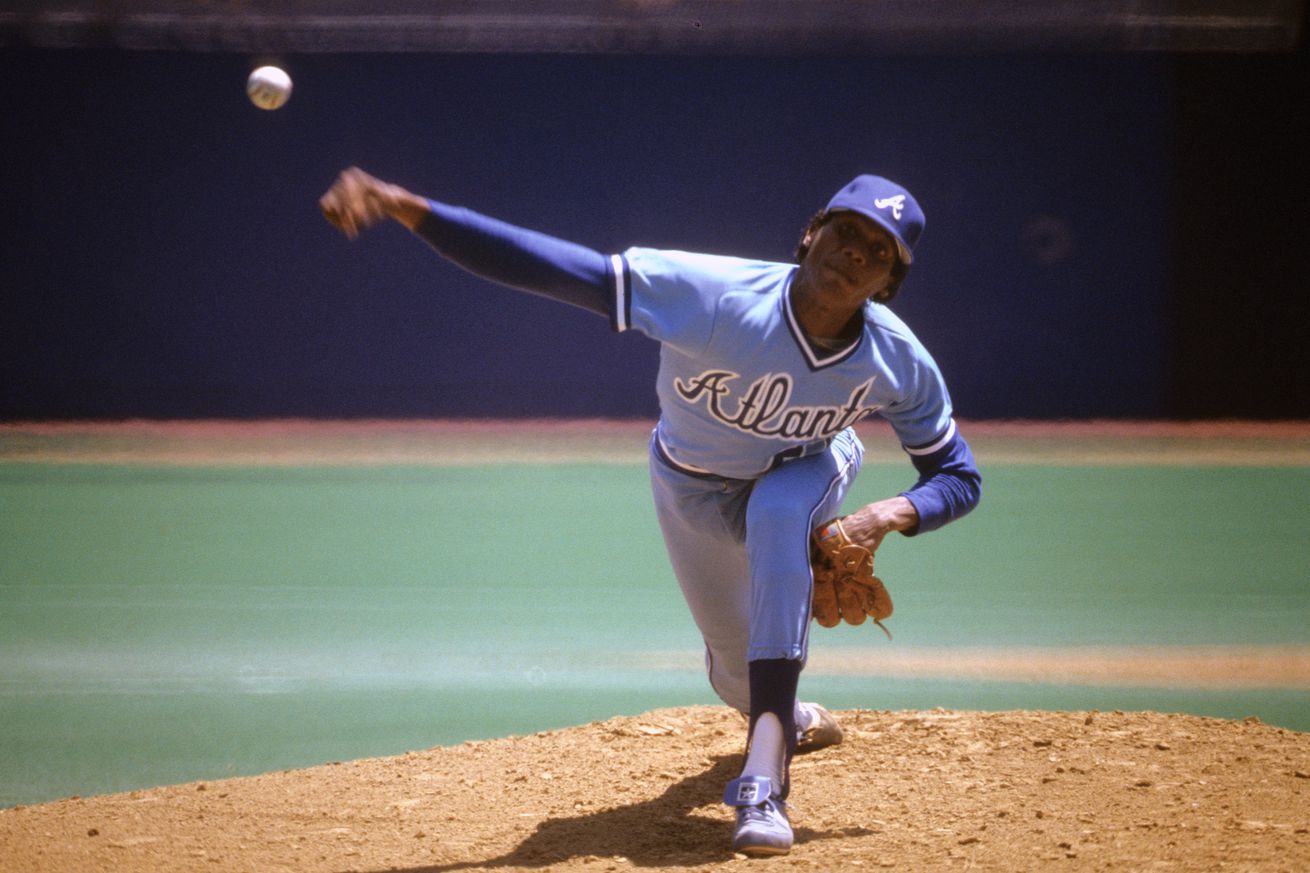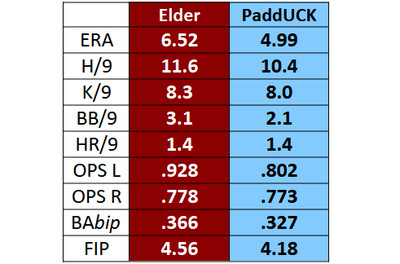
Last year, the Twins were 0-3 against Atlanta. But this is a new year!
First pitch: 6:15 Central
Weather: National Weather Service still gutted, 83° and sunny/dry, maybe???
Opponent’s SB site: Battery Power
TV: Steve Jobs (really Wozniak) TV+
Radio: When I got to the show, yo ho ho
What’s been up with Atlanta (5-13)? Well, star Ronad Acuna, Jr. keeps getting hurt. (Sound familiar?) And as Battery Power’s Ivan the Great puts it, “the pitching has looked anything but last year’s form.”
Today’s starter is Bryce Elder; he ain’t MY elder, but nobody in baseball is. Elder had a good (or lucky) first full season in 2023; last season was rough. He’s primarily a sinker/slider/change guy, and tops out in the low 90s. 2024 Digits:

This week had Jackie Robinson Day, so check out this interesting article about the ties between Robinson’s family and Japanese-Americans in Southern California. When Japanese-Americans were sent to (unconstitutional) internment camps during WWII, their empty homes/businesses were very often stolen or heavily vandalized. But the Robinsons, along with two other families, helped take care of their Japanese-American neighbors’ house. So they were able to move right back in when the war ended.
Twins fans sometimes travel to Atlanta for games, and I’ve heard from several who enjoyed the ballpark’s surrounding entertainment district. That’s nice. Well, it’s only estimated to lose Cobb County taxpayers an additional $15 million a year or so. Every year. From now until 2047. On top of the hundreds of millions taxpayers already gave the team’s owners. Stadiums never pay for themselves, surprise, surprise.
Today in Baseball History gives us this fascinating tidbit; on April 18, 2008, Tom Glavine was placed on the injured list. So what? He was 42, and it would be his last season. Well, Tom Glavine had never been on the injured list before. Not once. That’s unusual.
Also on April 18, in 2000, reliever John Rocker returned to the team after being suspended the first two weeks of the season. Rocker had been suspended for saying things in the media that were extremely bigoted, and today would get you a zillion-dollar radio deal or one of the cushier ambassador posts. What do our SB siblings at Battery Power think of Mr. Rocker? Not much. What about back in 2011? Even less.
Here’s a reasonably interesting 2018 article by Jeff Pearlman, who wrote the original “Rocker is a loudmouthed jerk” story for Sports Illustrated in 1999. Pearlman describes how the story got him hated by many clubhouses, for violating some sacred code of not telling baseball insider stories. (Which strikes me as ridiculous; this wasn’t stuff Pearlman went digging to find, it’s all stuff Rocker completely was happy to share. He probably just never thought he’d catch any flak for it.) Pearlman also describes feeling guilt that the story basically made his career, which has been very successful. And that it destroyed Rocker’s.
Well, hang on here. Rocker didn’t have to keep shooting off his mouth. He met with Hank Aaron and a Black mayor of Atlanta, and publicly said all the right, contrite things. At that point he could have shut the heck up, kept his bigoted feelings to himself, and after awhile the fans who booed him would have moved on. The same way they don’t boo Carlos Correa for the cheating stuff anymore (well, not much). It’s not Pearlman’s fault that Rocker continued to spout crap.
Also, Pearlman says Rocker’s on-field performance tanked after that 1999 article. Not true. He had a 2.89 ERA in 2000, and converted 24 of his 27 save opportunities, or 89%. (In 1999, it was 84%). It’s true that Rocker’s career fell off sharply after 2000. But his earlier success was probably not going to last — he walked a LOT of guys. BB/9 of 4.8 before that 1999 article — and he walked just as many in the minors. He was too wild, and batters figured out which pitches to lay off, and that was the end of John Rocker.
Rocker’s aggressive, boorish personality meant that the rotten stuff about him would have come out, sooner or later. It’s just his bad luck — and his own stupidity — that it came out before his incredibly high walk rate sank his career.
Our main story goes to the late Atlanta pitcher Pascual Pérez. I wrote about him back in 2016! Cut/paste activate!
On August 19, 1982, Atlanta had 25-year old righthander Pascual Pérez scheduled to start a getaway game against Montreal. Driving along I-285 to the stadium, Pérez missed his exit. Unfamiliar with Atlanta side streets (he’d only been traded there a few weeks before) and still early for the game, Pérez decided to take I-285 all the way around (it’s a loop freeway) until the stadium exit came up again.
That I-285 loop (referred to as “the Perimeter” by locals) is 64 miles long. And Pérez missed his exit again. How many times in all? Some tellings say twice, some three times. In any case, he missed the start. Running low on gas, he pulled into a convenience store, and the clerk, recognizing him, wondered why he wasn’t at the game yet.
It worked out fine. Rubber-armed knuckleballer supreme Phil Niekro made an emergency start, Atlanta won the game, and this missed start supposedly helped loosen up the clubhouse; his teammates made him a “Perez I-285” warmup jacket (you can see it here). Atlanta went on a nice winning tear and made the playoffs (where they got stomped). Pérez picked up and ran with the nickname “Perimeter Pascual.”
A Dominican native, Pérez originally signed with the Pirates in 1976, at age 19. He started his first game for Pittsburgh in 1980; played for Atlanta, the Expos, the Yankees. If you look at his career stats, they’re quite respectable, sporting a 3.18 ERA in his final season. Why did he leave baseball?
It was the 1980s, so take a guess — cocaine. Pérez had struggled with addiction since before he came to America, and that hard living sometimes got the better of him. He disappeared from dugouts, missed flights. In 1990 the Yankees employed famous ex-hard-living Dock Ellis to be something of Pérez’s mentor and drug counselor. It didn’t take, and more convictions/suspensions effectively ended Pérez’s career at age 34.
He wasn’t the only one amped up on chemicals at the time. Check out this INSANE fight from 1984 — which was payback for payback for payback for (etc.) after Pérez plunked a batter in the first inning. Yeah, most of these guys were either on coke, steroids, amphetamines, or all three (plus God knows what else) at once:
As you can see, the heightened macho factor was contagious; people were throwing beers on players from the stands. Five fans were arrested.
When Pérez was in control of his habit, he seemed like someone who really enjoyed the game. He flashed a ton of bling, wore his hair in decidedly 1970s fashion. With the Expos, he threw a no-hitter (if a drastically shortened rain-stopped version; what else would you expect? The normal kind?) This fine Grantland piece by Expos fan Jonah Keri describes some of Pascual’s more endearing pitching quirks:
Perez in his prime was a twitchy bundle of entertainment. Rail-thin at 6-foot-2, 162 (and probably skinnier than that), Perez was a taunting beanpole, punctuating strikeouts by shooting finger-guns toward home plate. If he put a runner on, he’d peer through his legs to keep tabs on him. If a strikeout ended a pressure-packed inning, you’d get the finger-gun, fist-pump, leap-off-the-mound shimmy shake, accompanied by a sprint to the dugout.
After leaving MLB, Pérez did TV ads mocking his “Perimeter Pascual” nickname; he played some semi-pro ball back in the Dominican.
On November 1, 2012, Pascual Pérez was murdered in his solo apartment by four assailants; apparently, one knew Pérez through dealer connections and planned to steal his $2,400 MLB pension. Among the many admiring obituaries was a nice one from Chris Strauss at USA Today.
And a touching musical tribute by The Baseball Project, several of whose members grew up in Atlanta. Minnesota native and badass drummer Linda Pitmon sings the vocals.
History ain’t always kind; sometimes hard to comprehend.